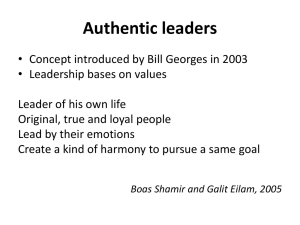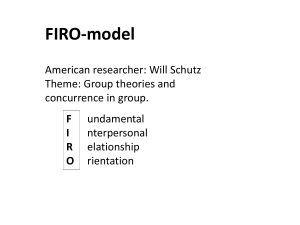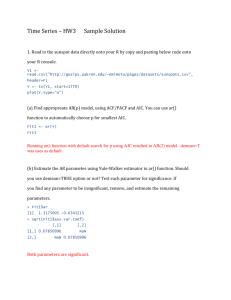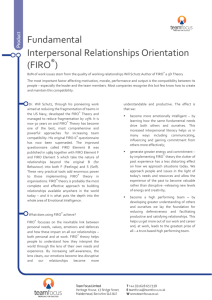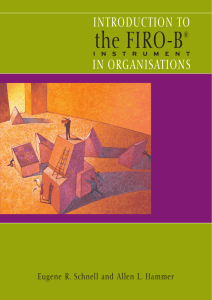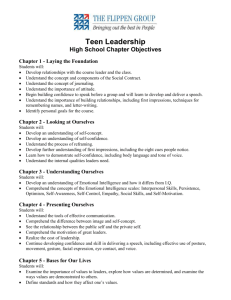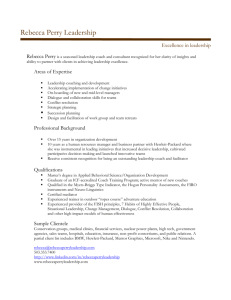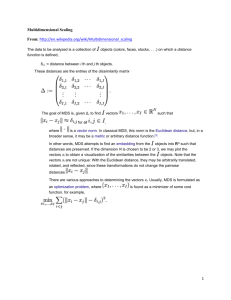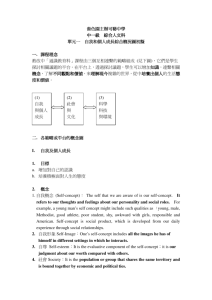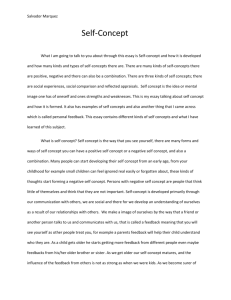A Brief Summary of FIRO Theory
advertisement
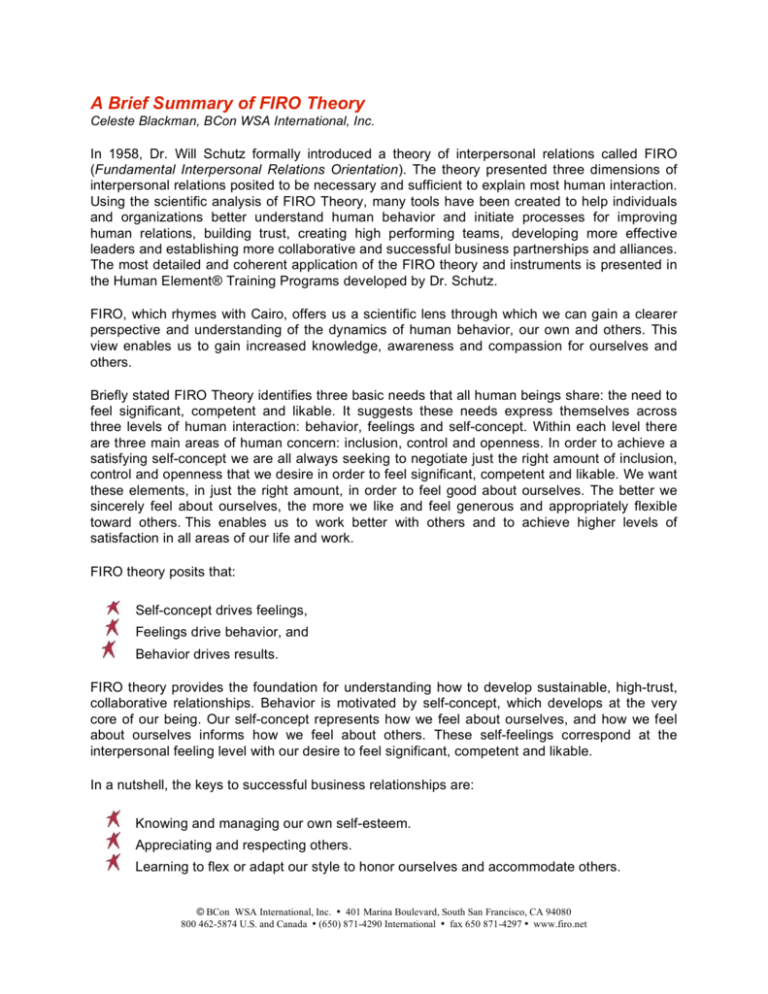
A Brief Summary of FIRO Theory Celeste Blackman, BCon WSA International, Inc. In 1958, Dr. Will Schutz formally introduced a theory of interpersonal relations called FIRO (Fundamental Interpersonal Relations Orientation). The theory presented three dimensions of interpersonal relations posited to be necessary and sufficient to explain most human interaction. Using the scientific analysis of FIRO Theory, many tools have been created to help individuals and organizations better understand human behavior and initiate processes for improving human relations, building trust, creating high performing teams, developing more effective leaders and establishing more collaborative and successful business partnerships and alliances. The most detailed and coherent application of the FIRO theory and instruments is presented in the Human Element® Training Programs developed by Dr. Schutz. FIRO, which rhymes with Cairo, offers us a scientific lens through which we can gain a clearer perspective and understanding of the dynamics of human behavior, our own and others. This view enables us to gain increased knowledge, awareness and compassion for ourselves and others. Briefly stated FIRO Theory identifies three basic needs that all human beings share: the need to feel significant, competent and likable. It suggests these needs express themselves across three levels of human interaction: behavior, feelings and self-concept. Within each level there are three main areas of human concern: inclusion, control and openness. In order to achieve a satisfying self-concept we are all always seeking to negotiate just the right amount of inclusion, control and openness that we desire in order to feel significant, competent and likable. We want these elements, in just the right amount, in order to feel good about ourselves. The better we sincerely feel about ourselves, the more we like and feel generous and appropriately flexible toward others. This enables us to work better with others and to achieve higher levels of satisfaction in all areas of our life and work. FIRO theory posits that: Self-concept drives feelings, Feelings drive behavior, and Behavior drives results. FIRO theory provides the foundation for understanding how to develop sustainable, high-trust, collaborative relationships. Behavior is motivated by self-concept, which develops at the very core of our being. Our self-concept represents how we feel about ourselves, and how we feel about ourselves informs how we feel about others. These self-feelings correspond at the interpersonal feeling level with our desire to feel significant, competent and likable. In a nutshell, the keys to successful business relationships are: Knowing and managing our own self-esteem. Appreciating and respecting others. Learning to flex or adapt our style to honor ourselves and accommodate others. © BCon WSA International, Inc. • 401 Marina Boulevard, South San Francisco, CA 94080 800 462-5874 U.S. and Canada • (650) 871-4290 International • fax 650 871-4297 • www.firo.net Why Self Matters How we feel about ourselves dictates our behaviors and impacts everyone around us. Being productive, creative, innovative, and ethical all evolve from the core of our being. What motivates human behavior is essential for unleashing human potential and productivity. We relate to each other from our outer layer of behavior. That behavior, however, is motivated by the current state of threat or non-threat experienced by our self-concept. The outside world sees only the behavior but not the vulnerability we may be experiencing at our core. If our outer behavior is manifesting as some form of defensiveness, (blaming, criticizing, ridiculing or attacking), then it is likely that our self-concept is feeling threatened and we perceive some external threat to our self. This sense of danger activates a feeling of fear, causing us to become defensive and a fear-response shows up in our behavior.. W. Edwards Deming, a pioneer in the field of quality control, maintained it would be impossible to achieve success in the workplace without first driving fear out of it. Why? Because he knew that fear in workers inhibits creativity, innovation and commitment to quality, moreover, it fuels dangerous tendencies in its victims, namely sabotage and retaliation. Quality is impossible when people are afraid to tell the truth. What are we afraid of? Internally, we are often misinterpreting the data that has signaled a potential threat in the environment. When someone else is acting in what we perceive to be a threatening manner, his/her behavior may not be intended to attack or hurt us. His/her own internal feeling of threat motivates the behavior. Rather than becoming defensive, a more useful approach is to move toward a behavior that invites the other person to feel safe and lowers your own internal reactiveness. Specifically, you can move toward safety and deescalate potentially conflicted situations by leaning how to help yourself and others feel significant, competent and likable. © BCon WSA International, Inc. • 401 Marina Boulevard, South San Francisco, CA 94080 800 462-5874 U.S. and Canada • (650) 871-4290 International • fax 650 871-4297 • www.firo.net All Human beings share some basic similarities All people want to feel: Significant Competent Likable All people have some fear of being: Ignored Humiliated Rejected All people have behavior preferences about: Inclusion Control Openness By creating environments that invite people to feel significant, competent and likable, you reduce the level of fear and create environments that are more conducive to honesty, collaboration, accountability and fun! It is in these environments where people bring their best to the workplace and productivity soars in an atmosphere of trust. By being accountable for your own internal environment, you take responsibility for your own psychological patterns and mental models and do not inappropriately associate your own deeper self-concept with the substantive issues you are working with. There are a number of FIRO based methods to help you build a more trusting work environment. The most comprehensive is The Human Element approach, which provides an integrated approach for addressing all the human needs in an organization. It delivers a philosophy and a technology for activating the theory at work and at home. The Elements of awareness, a series of assessment tools created by Will and his associates, create practical uses for the theory ranging from managing conflict, to developing leaders and providing meaningful employee feedback. The most popular among these tools is the Element B™. The Element B After introducing FIRO Theory in the 1950’s Will created the FIRO-B as a tool to measure the interaction between two people for research purposes. People soon found many other uses for the theory and the instrument and it became one of the most widely used training tools in the world. Over the next 45 years Will devoted his creativity, and scientific curiosity into developing practical applications that made FIRO Theory immediately useful in everyday life. The Element B evolved from his continued research, experimentation and unyielding desire to better understand and predict human behavior. To learn more about FIRO Theory and the tools that support it, contact Celeste at 1-800 inclusion (462-5874) or celeste@firo.net. Visit our web site at www.firo.net © BCon WSA International, Inc. • 401 Marina Boulevard, South San Francisco, CA 94080 800 462-5874 U.S. and Canada • (650) 871-4290 International • fax 650 871-4297 • www.firo.net
